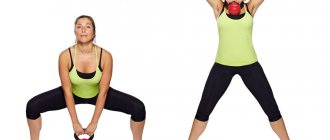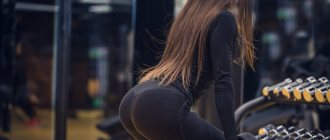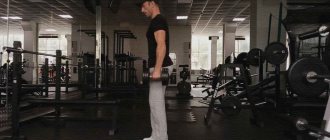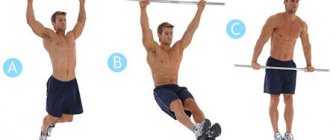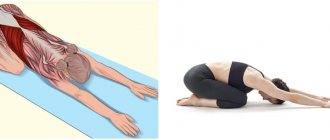Not everyone can devote extra time and money to visiting the gym, but everyone wants to have a healthy back, beautiful posture and elastic muscles. Not only classes in a fitness club, but also simple exercises at home can help you achieve beautiful shapes and a slender body. One of these exercises that can be performed even at home is hyperextension, which is aimed at developing, first of all, the back muscles, and does not require machines or dumbbells; all you need to do is your own body weight and determination!
- Hyperextension: the purpose of the exercise
- Benefits of Hyperextension
- Technique for performing hyperextension at home
- Video instructions for the hyperextension exercise
- Reverse hyperextension to perform at home
- “Boat” or hyperextension with simultaneous raising of arms and legs
- Video: boat exercise technique
- Hyperextension on a fitball
- Direct hyperextension on a fitball
- Video: hyperextension on a fitball
- Reverse hyperextension on a fitball
- Video tutorial on performing reverse hyperextension on a fitball:
- Lateral hyperextension on a fitball
- Practical tips for performing hyperextension
Hyperextension: the purpose of the exercise
The greatest load when performing hyperextension falls on the lower back - the extensor muscles that are connected to the spine. In addition to them, the hamstrings, semitendinosus and semimembranosus muscles of the thigh, as well as the calves and buttocks are activated during the work. Thus, hyperextension serves the following purposes:
- Strengthening the muscle corset (this maintains the tone and health of the back).
- Development of the gluteal, thigh and calf muscles (correction of their shapes and volumes).
- Preparing muscles to perform more complex, basic exercises.
- Supports overall muscle tone.
- Development of abdominal muscles, burning fat in the abdominal area (in some types of hyperextension).
Application of the exercise
The main purpose of performing hyperextension is to train the muscles of the lower back (back extensors), hamstrings and gluteal muscles. This is a strengthening exercise - the result of the exercise will not be an increase in mass, but a strong, trained back muscle corset that can support the spine well.
In gyms, exercise machines of various designs are used to perform this exercise. They are designed to perform hyperextension in a horizontal or inclined position. If you don’t have time to visit the gym, then the exercise can be easily done at home.
Hyperextension will be especially relevant for those who are just starting to play sports. When performing many exercises, the back is actively involved in the work and experiences significant stress. Hyperextension at home will help strengthen weak back extensor muscles.
Hyperextension is no less useful for people experiencing problems with the spine. It is often recommended as an exercise for back pain. Regularly performed hyperextension at home or in the gym will ensure gradual strengthening of the lumbar area.
Hyperextension will be a solution for those who lead a sedentary lifestyle, which results in scoliosis, osteochondrosis, as well as for people suffering from vertebral hernias and protrusions. Due to the fact that the main impact is directed specifically at the muscular corset of the back, the possibility of injury is minimized.
The exercise can be performed by people of any age, with different levels of physical fitness. It is contraindicated only in patients with lumbosacral trauma and acute back pain.
Benefits of Hyperextension
The main advantage of hyperextension is the absence of strong load on the vertebrae at all stages of the exercise. A small range of flexion is enough to activate the back muscles. In addition, frequent hyperextension exercises relieve back and lumbar pain. As already noted, the exercise does not require special equipment or sports equipment. In addition to strengthening the spine, hyperextension affects the functioning of the tendons. If you work out at home without a barbell or dumbbell machine, a back curl session will prepare your body for weight training.
Technique for performing hyperextension at home
The classic version of the exercise is performed in a lying position on the floor, bench, sofa or bed. Leg position: you can independently hold your feet flat or put a heavy object (bag, bar) on your ankles. If you have an assistant, ask him to hold your feet so that they do not leave the floor during the exercise. Next, follow the steps of the technique:
- Focus on the abdominal and thigh muscles, your feet should rest your toes on the floor.
- Stretch your arms at your sides or put them behind your head. You can also stretch your arms forward and spread them to the sides as you lift your body off the floor.
- As you exhale, lift your body, slowly arching your back.
- As you inhale, lower yourself to the starting position.
Number of approaches and repetitions: 3×10.
The correct technique for performing horizontal hyperextension while lying on the floor with emphasis on the hips.
The correct technique for performing horizontal hyperextension while lying on the floor with emphasis on the hips
Video instructions for the hyperextension exercise
My sport life
November 23, 2016
| no comments
It is almost impossible to overestimate the benefits of an exercise such as hyperextension. It is indicated not only for those who go to the gym and want to build muscle mass, but for those who do not play sports, but think about their health.
In terms of its action, this is the best exercise for the lower back, but it has one significant drawback, or rather the presence of a special simulator. Unfortunately, to perform hyperextension, a simulator is necessary and without it you simply will not be able to perform this movement as efficiently as possible.
However, there are a NUMBER OF ALTERNATIVES AND EXERCISES THAT ARE VERY SIMILAR IN THEIR ACTION AND EFFECTIVENESS , and they can be easily performed not only in the gym, but also at home.
An exercise such as good morning or good morning has been known for decades, although it still remains underestimated. ITS MAIN ADVANTAGE is that you can load the lower back exactly as much as necessary, which is not always possible when performing regular hyperextension.
When performing the exercise, it is very important to ensure that the back remains straight, does not round, and that a natural arch remains in the lower back. Perhaps, at first, not all people will be able to do deep forward bends, which is associated with insufficient flexibility, so you need to do good mornings as much as your stretching allows.
This movement is as close as possible to the hyperextension technique, but has a number of significant advantages that should not be ignored.
- Approaches – 3;
- Repetitions – from 10 to 12;
Features and technique – moderate weight (it is better not to overload the lower back), slow and smooth movements, place the barbell (dumbbells or even a kettlebell) on the rear delts or in the area of the shoulder blades.
Also read: Squats (without weights): guaranteed toned buttocks and slender legs
If we consider the MOST SUITABLE EXERCISES FOR THE LOWER AT HOME, then superman is the most ideal.
Firstly, this exercise perfectly loads the muscles of the lower back, and secondly, static load will not lead to injuries and is indicated even for those who have problems with the lower back.
For those who already find it easy to perform this exercise without weights, you can significantly complicate the technique by using any weights. Plates, weights, dumbbells, or even a regular 5-6 liter water bottle are suitable for this.
The load should be evenly distributed on the back (between the shoulder blades, just below the neck), and in the popliteal region (can be shifted to the hips or calves, varying the load).
- Approaches – 2-3;
- Duration – until complete failure;
Features - since this is a static exercise, it is important to maintain maximum deflection all the time, concentrating the load in the lumbar region. Jerking and swaying should not be allowed. When working with weights, it is better to work with an assistant who can quickly and evenly load the weight.
Also read: Lunges: types, technique and benefits of the exercise
Another great static exercise for the lower back, which evenly loads almost all muscles. The main emphasis when performing a plank usually falls on the stomach, although to stabilize the load, the lower back is also fully involved in the work. At the same time, the plank makes it possible to develop deep muscles that are almost not used when performing regular exercises in the gym.
Moreover, you can always perform both elbow and plank exercises with outstretched arms, varying the load and the angle of inclination of the body.
- Approaches – 2;
- Duration – until failure (but no worse than the previous result);
Features - the body should be straight, from the neck to the feet, forming one line. Over time, you can make the plank more difficult not only due to the time in the approach, but also by changing the inclination (alternating the elbow support and the emphasis on outstretched arms).
Also read: Plank and its types: an indispensable exercise for all times
A very simple and effective exercise for the lower back and abdomen, which, if all the rules and techniques are followed, will be a good alternative to hyperextension.
Although the degree of load in this type of movement is much less, it is incredibly useful, as it allows you to relieve the load on your back. That is why THIS MOVEMENT IS RECOMMENDED FOR THOSE WHO SPEND A LOT OF TIME IN A SITTING POSITION or often place axial load on the spine.
Also, a cat/dog stretches the abdominal muscles, improving their tone, and it can be done at any level of physical fitness and in any conditions, unlike hyperextension.
- Approaches and repetitions – unlimited, but not less than 15 times in a row.
- Do this exercise for a time or until you feel tired, but do not overdo it.
Also read: 12 most effective exercises for beautiful and toned buttocks
Categories: What can you train at HOME without having exercise equipment?
| Tags: hyperextension, hyperextension technique, hyperextension trainer, good morning exercise, plank, superman exercise, cat/dog exercise, exercises for the lower back, exercises for the lower back at home
Reverse hyperextension to perform at home
The target muscles of reverse hyperextension also include the back extensors, gluteus maximus, biceps femoris, and rectus abdominis. Feature of the exercise: in this case, bending is carried out not by the upper part of the body, but by the lower part, i.e., with the legs. To perform reverse hyperextension, use a stable support: chairs, table or bench. Below you will find explanatory photos and videos.
- Lie on a support so that the upper part of the body is supported, and the lower part is hanging freely, with your toes touching the floor.
- Grab the support with your hands and, as you exhale, begin to slowly raise your legs, working your back muscles.
- Try to reach the maximum point, then inhale and lower your hips to the starting position.
Number of approaches and repetitions: 3×12–15 times.
Stages of performing reverse hyperextension at home with emphasis on a table
If you do not find comfortable support, reverse hyperextension can also be performed from the floor. The starting position will be as follows: lie on your stomach, place your head on your crossed arms, bend your knees, and point your feet up. Lift your hips off the floor, fixing your upper body on the floor.
Correct technique
Before starting classes, adjust the height according to your height. The top edge of the hip pads is where the hips and lower back flex, and the bottom edge is just above the Achilles tendon.
Starting position: legs are placed behind the lower support rollers, the torso is placed in line with the legs.
Strongly straining the muscles of the buttocks, tilt the torso forward so that the angle between the upper and lower parts of the body does not exceed 60 degrees. The back should be slightly rounded. At the lowest point, arms are crossed over the chest. Then, smoothly, without growling, they lift the body up, and again take the starting position and linger in it for a second, after which they lower the body forward again.
Breathing mode: when lowering - inhale, when rising - exhale. To make it easier for beginners, it is allowed to place the hands on the back of the head, the angle between the elbows should be 180 degrees.
“Boat” or hyperextension with simultaneous raising of arms and legs
The well-known “boat” is one of the types of hyperextension; its technique combines elements of forward and reverse bending. The exercise is ideal for doing gymnastics and fitness at home. To perform the “boat” you will need a gymnastic mat or other soft but flat support.
Technique for performing a ball boat: correct placement of arms and legs
- Lie on your stomach, straighten your legs, stretch your arms above your head.
- As you exhale, use your abdominal muscles to bend your back and at the same time raise your arms and legs.
- Keep your head straight, do not spread your hands and feet to the sides.
- After passing the highest point, inhale and slowly return to the starting position.
Number of approaches: 3.
Number of repetitions: 12–15.
Video: boat exercise technique
With or without additional weight: which is better?
Often, unweighted hyperextension is performed during a warm-up to better warm up the muscles before serious exercises, such as squats or deadlifts. In this case, the warm-up is always performed without weights.
If hyperextension is part of a set of basic exercises for working the back muscles, the athlete is recommended to start working with his own weight and gradually add weights.
As a rule, the weight of the weight can be increased when the athlete is able to perform 3 x 15 repetitions without much effort.
Hyperextension at home without a machine
Hyperextensions are fairly easy to perform at home without a machine, although some variations may require a partner to support the practitioner’s legs.
To practice at home, you can use a bench, sofa, or even perform the exercise on the floor.
Option 1.
- Take the starting position lying face down on the floor;
- Inhale and simultaneously raise your legs and arms extended forward. You should try to lift your legs off the floor at the hips.
- Try to stay in this position for about 10 seconds.
- Return to the starting position.
Option 2.
- Take your starting position lying face down on the floor, stretch your arms forward;
- Raise your right arm and left leg.
- Try to stay in this position for about 10 seconds.
- Return to the starting position.
- Raise your left arm and right leg and hold.
- Return to original.
Hyperextension on a fitball
If you are the proud owner of a fitball, three more techniques for performing hyperextension are available to you: direct, reverse and lateral. The basis of the exercise remains the same as in classic hyperextension. With direct bending, the body is lifted with emphasis on the fitball, with reverse bending, the legs are lifted, and lateral bending is performed with emphasis on the lateral part of the thigh. Let's consider a step-by-step execution technique for each case:
Direct hyperextension on a fitball
Position of the body when performing hyperextension on a fitball
- Lie on your stomach on the exercise ball so that the main emphasis is on your lower abs and upper thighs.
- Place your feet firmly on the floor.
- Place your hands behind your head or cross them over your chest.
- Start making amplitude movements: lower and raise your body, bending at the lower back.
- Try to perform the exercise using the target muscles, eliminating mechanical inertia.
Number of approaches and repetitions: 3×12 times.
Video: hyperextension on a fitball
Reverse hyperextension on a fitball
Stages of the exercise: initial and peak position of the body
Stages of the exercise: initial and peak position of the body in space
- Lie on your stomach on the exercise ball so that your body is parallel to the floor.
- Place emphasis on both palms, bend your arms slightly at the elbows.
- As you inhale, begin to slowly raise your legs, tensing your abdominal muscles.
- Then lower them to the starting position.
Number of approaches and repetitions: 3×12 times.
Reverse hyperextension on a fitball, in addition to the main target muscles, makes the gluteal muscles actively work.
Video tutorial on performing reverse hyperextension on a fitball:
Lateral hyperextension on a fitball
To make the oblique abdominal muscles burn, perform lateral hyperextension:
- Lie on the side of your thigh with the support on the exercise ball.
- Place your hands behind your head, rest your feet on the floor.
- Start doing god curls.
- On inhalation - body up, on exhalation - down.
Number of sets and reps: 3x10 on each side.
Peak body position when performing lateral hyperextension on a fitball
Reverse hyperextension
If you want to work your hips and lower back, you can supplement the standard complex with reverse hyperextension. To perform the exercise, you need a separate bench with stationary weights. It is not advisable to purchase such a simulator for an apartment. But you can adapt to training at home.
Reverse hyperextension at home is performed using simple sports equipment.
On fitball
Lie on your stomach on the ball, place your hands on the floor and slowly raise your legs until your body is completely straight. This variation of training also develops coordination, since the athlete has to maintain balance and maintain balance so as not to fall off the fitball.
On the Bosu hemisphere
If you still can’t maintain balance on a fitball, you can do leg lifts from a balancing pad. The execution technique does not change. The athlete lies down on the flat part of the hemisphere and puts his hands behind his head. If Bosu is equipped with handles on special elastic cords, then you can maintain your balance with them. You can also help yourself by resting your palms on the floor.
On a horizontal bench
Position yourself so that your stomach and chest lie completely on the bench. Straighten your legs and lower them so that your toes touch the floor. Stretch your neck forward and clasp the legs of the machine with your hands. Slowly raise and lower straight legs (20-30 times in one approach).
Reverse hyperextension can also be performed from a lying position on the floor. The athlete will need to simultaneously raise straight arms and legs.
Hyperextension is a simple but effective exercise that will strengthen the muscle corset and make your back sculpted. To start training, just lie down on the floor.
Practical tips for performing hyperextension
When performing various variations of hyperextension, adhere to the following rules, which will allow you to hone your execution technique and increase the effectiveness of your training:
- Don't lower your body too low.
- Do not lift your body high (there should be no pain in the spine).
- Do not swing, do not do the exercise inertia. Try to control every movement.
- Perform lifting and lowering slowly and with concentration.
- Do not bend your knees; the body should be “tight”.
- Do not use additional weights in the exercise (you can increase the load only after gaining significant experience in performing hyperextensions).
- If you have diseases associated with impaired functioning of the muscles of the lower back and back, contact a specialist and find out whether this exercise can be performed in your case.
Hyperextension is suitable for men and women of all ages. It is used not only as a training element to create a beautiful, strong back, but also as a general prevention of various diseases of the joints and muscles. To make the exercise as effective and safe as possible for yourself, it is important to follow the rules for its implementation: to do this, try to study the technique of compound movements theoretically and practically. Be sure to include forward and reverse hyperextensions in your warm-up workout. This will prepare your muscles for more difficult exercises and eliminate the possibility of mechanical injury.
How to do the exercise?
Before you begin the exercise, you should make sure that you have a flat, level surface on which you can lie on your stomach and hang your legs. This surface should be located at the height of the person’s legs.
Step-by-step technique:
- You need to lie on a flat surface with your stomach down. In this case, the body should be fixed with your hands.
- The lower limbs are lifted upward by the muscles of the thigh and buttocks.
- As you inhale, they are raised as high as possible. The muscles of the thighs and buttocks should be as tense as possible.
- You should stay in this position for a minute, and then lower your legs down. At the same time, exhale.
- The number of repetitions of the exercise is 12-15. Then a short break follows and another approach is performed. The number of approaches can be equal to 2-3.
